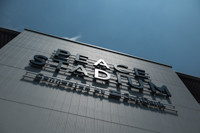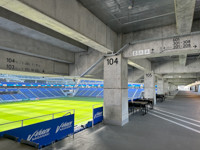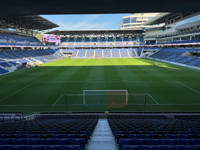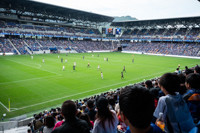PEACE STADIUM Connected by SoftBank
| Capacity | 20 027 |
|---|---|
| Country | Japan |
| City | Nagasaki |
| Clubs | V-Varen Nagasaki |
| Inauguration | 14/10/2024 |
| Construction | 2022–2024 |
| Cost | ¥100 B ($657 M) – entire complex |
| Design | Yasui Architects & Engineers |
| Contractor | Takenaka Corporation |
Advertisement
PEACE STADIUM Connected by SoftBank – stadium description
How did the new stadium for V-Varen Nagasaki come about?
In 2017 the financially troubled V-Varen Nagasaki football club was taken over by the team's previous main sponsor, Japanet Holdings. Later that year, V-Varen won a historic promotion to the J1 League, although its first stay in the top division only lasted for one season.
In addition to investing in the team, Japanet Holdings (a holding company that includes Japanet Takata, a leader in the mail-order business in Japan) also planned to build a new stadium for V-Varen. At the time of the club's acquisition, the team played its games at Transcosmos Stadium Nagasaki which is located in the city of Isahaya, more than 20 kilometers east of Nagasaki.
How was a plot of land found in downtown Nagasaki to build a new stadium for V-Varen?
In July 2015, Mitsubishi Heavy Industries announced a plan to reorganize its factories in the Nagasaki area, which called for the closure of the Saiwaimachi plant, in downtown Nagasaki, by the end of 2017. In connection with this plan, in early 2017 Mitsubishi Heavy Industries called on interested parties to submit bids to take over the factory.
The bids were to include an investment plan that should address the needs of local residents, create new jobs and revitalize the site to make it an attractive public space. One of the companies that submitted a bid was Japanet Holdings. The main thrust of Japanet Holdings' plan was to build a new stadium for V-Varen Nagasaki on the site of the old factory, in addition to a hotel and other commercial facilities.
Japanet Holdings' proposal was well evaluated and a contract for the sale of the site was signed in November 2018. The design of the entire development site, which was named Nagasaki Stadium City, was done by Yasui Architects & Engineers. Prior to the start of the development, plans were still being revised, including integrating the hotel building with the stadium and adding a sports hall to the complex.
The design of the new stadium for V-Varen Nagasaki can be seen on a separate subpage
How did the construction of the new V-Varen Nagasaki stadium proceed?
The buildings of the old factory were demolished in 2020, and the groundbreaking ceremony for the new complex took place on June 26, 2022. Construction work went very smoothly, and the cost of completing the entire project was about 100 billion yen. The Nagasaki Stadium City construction site was divided into four segments, and the main contractor for Section I, which includes the stadium, hotel and shopping mall, was Takenaka Corporation.
What is the name of the new V-Varen Nagasaki stadium?
In December 2022, a partnership was announced with ICT company SoftBank, which included the sale of the stadium's naming rights, so a new name for the facility was established (“PEACE STADIUM Connected by SoftBank”), including a message for peace.
When was the new V-Varen Nagasaki stadium inaugurated?
Nagasaki Stadium City was opened in October 2024, and the new stadium had its pre-inauguration on October 6, 2024 on the occasion of the 34th round J2 League match between V-Varen Nagasaki and Oita Trinita (4–1). On October 13, the stadium hosted a concert by Masaharu Fukuyama.
The grand opening of the complex took place on October 14, 2024, culminating in a ribbon-cutting ceremony. This was no ordinary ribbon, as it was as long as 5 kilometers and stretched across all 5 main buildings of Nagasaki Stadium City. The cutting was done jointly by about a thousand people, cutting the ribbon one by one, piece by piece.
What does PEACE STADIUM Connected by SoftBank look like?
The V-Varen Nagasaki Stadium has a rectangular, football-specific layout, and its stands are very close to the pitch (the closest seats are just 5 meters from the field). The auditorium is roughly divided into two tiers and is equipped with folding seats in blue hues (in reference to the colors of the sea and sky).
The capacity of the stands is 20,027 spectators, with the main stand located on the west side. A variety of premium options are available for spectators. Two corners have been equipped with video screens.
Towering over the stadium is the hotel building, which is integrated with the east stand. The hotel stretches along this stand and has 14 above-ground floors, reaching a height of about 60 meters. Some of the hotel rooms have views of the stadium.
The stadium's stands have been fully roofed. The roof is formed by four separate segments above each stand. Under the roof there are floodlights. The canopy in the eastern section (facing the hotel) is made of glass, and in the southern section it has been extended outward, covering the passage between the stadium and the shopping mall.
What is Nagasaki Stadium City?
The V-Varen Nagasaki stadium was built as the main component of a complex called Nagasaki Stadium City. In addition to the stadium and its integrated hotel, the complex consists of an office building and sports hall, which are located behind the north stand, and a shopping mall, located behind the south stand.
The sports hall, which has the commercial name “HAPPINESS ARENA”, can accommodate a maximum of 6,000 spectators (part of the stands are foldable). Under the roof of the arena hangs a large four-screen videoboard. The arena is hosted by the professional basketball team, Nagasaki Velsa. On the roof of the arena are small courts.
An interesting feature is the zip line, which has been stretched above the stadium, from the office building to the shopping mall. It is possible to use it on days when there are no events at the stadium.
Where is the V-Varen Nagasaki stadium located?
The stadium is located in downtown Nagasaki, on the Urakami River, on the site of the former Mitsubishi Heavy Industries factory. The facility is located about 1.5 kilometers south of so-called “ground zero”, the hypocenter of the 1945 atomic bomb explosion, and less than a kilometer north of the Nagasaki Railway Station.
Advertisement
Pictures
-

10.2024 © Nagasaki Stadium City 
2024 © Nagasaki Prefecture Tourism Association 
10.2024 © Nagasaki Stadium City 
07.2024 © Nagasaki Stadium City 
01.2025 © Nagasaki Stadium City 
10.2024 © V-Varen Nagasaki 
09.2024 © V-Varen Nagasaki 
10.2024 © V-Varen Nagasaki 
10.2024 © V-Varen Nagasaki 
2024 © Nagasaki Prefecture Tourism Association 
10.2024 © V-Varen Nagasaki 
10.2024 © V-Varen Nagasaki 
08.2024 © Nagasaki Stadium City 
10.2024 © V-Varen Nagasaki 
10.2024 © V-Varen Nagasaki 
10.2024 © V-Varen Nagasaki 
09.2024 © V-Varen Nagasaki 
09.2024 © V-Varen Nagasaki 
10.2024 © V-Varen Nagasaki 
01.2025 © V-Varen Nagasaki 
01.2025 © V-Varen Nagasaki 
10.2024 © V-Varen Nagasaki 
01.2025 © V-Varen Nagasaki 
10.2024 © V-Varen Nagasaki 
2024 © Nagasaki Prefecture Tourism Association 
10.2024 © V-Varen Nagasaki 
10.2024 © V-Varen Nagasaki 
12.2024 © Nagasaki Stadium City 
11.2024 © Nagasaki Stadium City 
10.2024 © Nagasaki Stadium City 
12.2024 © V-Varen Nagasaki 
10.2024 © V-Varen Nagasaki 
10.2024 © V-Varen Nagasaki
Related news
2025
-

SOTY: Last hours to vote for your Stadium of the Year 2024
Have you chosen your top 5 stadiums opened in 2024? You have until the end of the week to vote in the 15th edition of our annual competition. Bernabéu, Mas Monumental, Stadion Utama Sumatera Utara, or Egypt Stadium? But there are many more nominees—check the full list one more time and make your choice!
-

Japan: Peace stadiums in Hiroshima and Nagasaki - a kilometer from ground zero
Picturesque, modern, built over a river. Although separated by 300 kilometers, the new stadiums in Hiroshima and Nagasaki are united by the word "peace" in their names, a reminder of the atomic holocaust that befell both cities in 1945 just a few hundred meters from both arenas' present locations.
-

SOTY: Say hello to your new favorite stadium!
Which one? The choice is yours, and it’s a big one. 23 stadiums are competing in this year’s Stadium of the Year contest. The lineup? Impressive. The competition? Fierce. Cast your vote and share it with your fellow football fans!
-

SOTY: Get ready to choose your favorite stadium
On February 3rd at 00:00 CET (Central European Time), the annual Stadium of the Year competition will begin, allowing fans to select the best stadium inaugurated in 2024. This will be the 15th edition of the contest, which we have organized continuously since 2010. This year, the selection features some of the largest stadiums in the world.
-

Stadium of the Year 2024: Play your part in celebrating 22 new stadiums
Exactly that many stadiums were opened in the past year, 2024—unless, of course, we’ve overlooked one. This is your chance to catch us slipping! Check out the list of venues participating in the Stadium of the Year competition and share your own suggestion for a stadium that opened in recent months.

 StadiumDB
StadiumDB